Physical Address
304 North Cardinal St.
Dorchester Center, MA 02124
The construction of the tissues of the body involves developmental phenomena at two levels of organization. One is the level of individual cells, in which the cells that make up a tissue undergo increasing specialization through a process called cytodifferentiation (see discussion of restriction, determination, and differentiation [p. 84]). At the next level of complexity, various cell types develop in concert to form specific tissues through a process called histogenesis . This chapter discusses the development of three important tissues of the body: skin, bone, and muscle. The histogenesis of each of these tissues exemplifies important aspects of development.
The skin, consisting of the epidermis and dermis, is one of the largest structures in the body. The epidermis represents the interface between the body and its external environment, and its structure is well adapted for local functional requirements. Simple inspection of areas such as the scalp and palms shows that the structure of the integument varies from one part of the body to another. These local variations result from inductive interactions between the ectoderm and underlying mesenchyme.
The outer layer of the skin begins as a single layer of ectodermal cells ( Figure 9.1A ). As development progresses, the ectoderm becomes multilayered, and regional differences in structure become apparent.
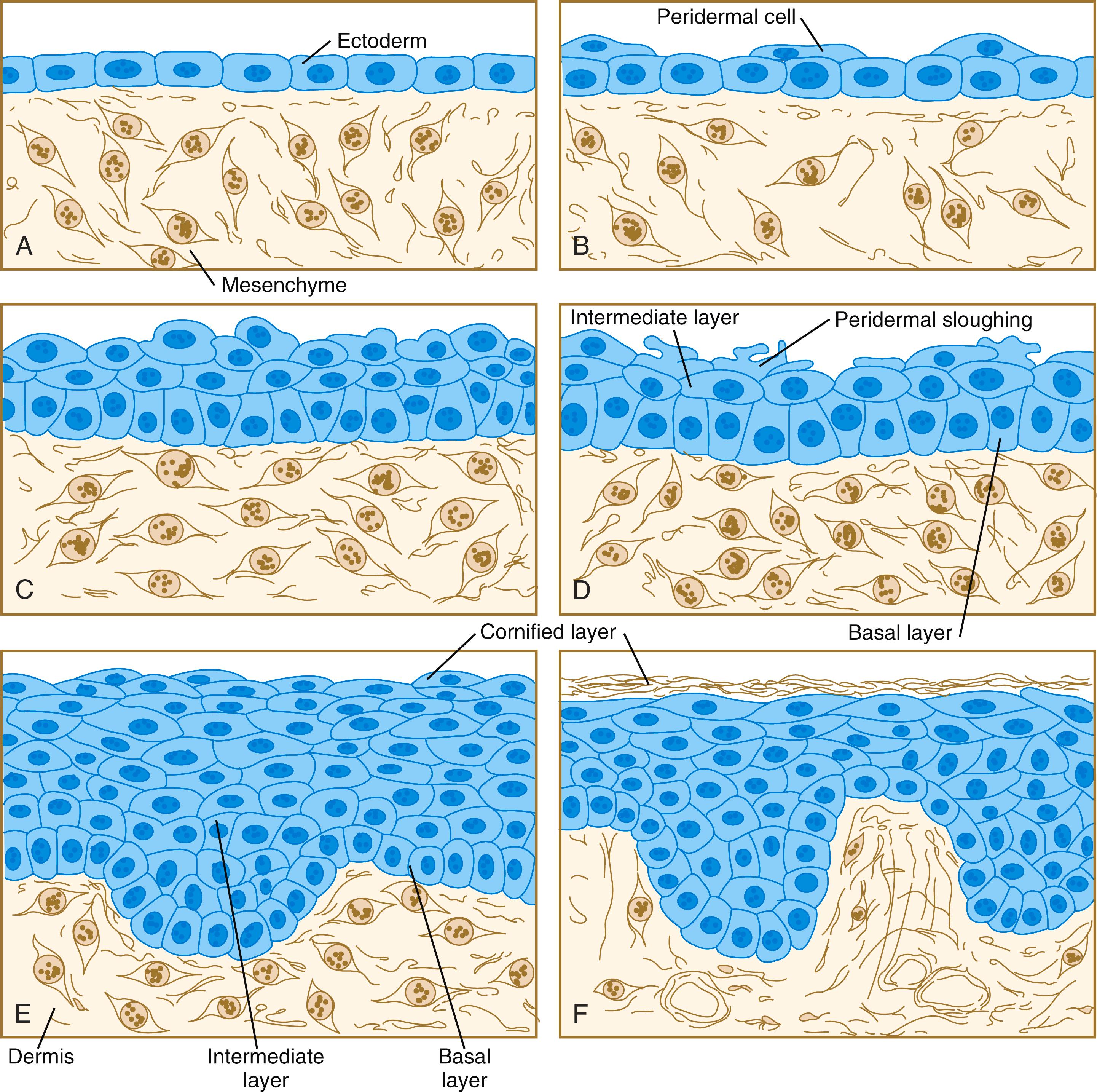
The first stage in epidermal layering is the formation of a thin outer layer of flattened cells known as the periderm at the end of the first month of gestation ( Figure 9.1B ). Cells of the periderm, which is present in the epidermis of all amniote embryos, are involved in the exchange of water, sodium, and possibly glucose between the amniotic fluid and the epidermis.
By the third month, the epidermis is a three-layered structure, with a mitotically active basal (or germinative ) layer , an intermediate layer of cells ( Figure 9.1D ) that represent the progeny of the dividing stem cells of the basal layer, and a superficial layer of peridermal cells bearing characteristic surface blebs ( Figure 9.2 ). Peridermal cells contain large amounts of glycogen, but the function of this glycogen remains uncertain.

A major function of periderm is to prevent adhesions between various external body parts during the embryonic and early fetal periods. Mutations that inhibit the formation of periderm result in cutaneous webbing across multiple joints, syndactyly (see p. 205), genital abnormalities, and certain facial abnormalities. On the other hand, persistence of periderm can result in cleft lip/palate because breakdown of the periderm is necessary for the fusion of the palatal shelves (see p. 308).
During the 6th month, the epidermis beneath the periderm undergoes differentiation into the definitive layers characteristic of the postnatal epidermis. Many of the peridermal cells undergo programmed cell death ( apoptosis ) and are sloughed into the amniotic fluid. Starting at approximately 20 weeks, the epidermis becomes a barrier between the fetus and the outside environment instead of a participant in exchanges between the two. The change in function of the fetal epidermis may have adaptive value because it occurs at about the time when urinary wastes begin to accumulate in the amniotic fluid.
Despite its homogeneous histological appearance, the epidermis is really a cellular mosaic, with contributions from cells derived not only from surface ectoderm but also from other precursors, such as the neural crest or mesoderm. These cells play important specific roles in the function of the skin.
Early in the second month, melanoblasts derived from the neural crest migrate into the embryonic dermis; slightly later, they migrate into the epidermis. Although melanoblasts can be recognized early by staining with a monoclonal antibody (HMB-45, which reacts with a cytoplasmic antigen common to melanoblasts and melanomas [pigment cell tumors]), these cells do not begin to produce recognizable amounts of pigment until midpregnancy. This production occurs earlier in heavily pigmented individuals than in individuals with light complexions. The differentiation of melanoblasts into mature melanocytes involves the formation of pigment granules called melanosomes from premelanosomes .
The number of pigment cells in the skin does not differ greatly among the various races, but the melanocytes of dark-skinned individuals contain more pigment granules per cell. Albinism is a genetic trait characterized by the lack of pigmentation, but albinos typically contain normal numbers of melanocytes in their skin. The melanocytes of albinos are generally unable to express pigmentation because they lack the enzyme tyrosinase , which is involved in the conversion of the amino acid tyrosine to melanin .
Late in the first trimester, the epidermis is invaded by Langerhans’ cells , which arise from precursors in the yolk sac. These cells are peripheral components of the immune system and are involved in the presentation of antigens; they cooperate with T lymphocytes (white blood cells involved in cellular immune responses) in the skin to initiate cell-mediated responses against foreign antigens. Langerhans’ cells are present in low numbers (approximately 65 cells/mm 2 of epidermis) during the first two trimesters of pregnancy, but subsequently their numbers increase severalfold to 2% to 6% of the total number of epidermal cells in the adult.
A third cell type in the epidermis, the Merkel cell , appears in palmar and plantar epidermis at 8 to 12 weeks of gestation and is associated with free nerve terminals. Originally thought to be derived from neural crest, Merkel cells are now known to arise from epidermal cells. These cells function as slow-adapting mechanoreceptors in the skin, but cytochemical evidence suggests that they may also function as neuroendocrine cells at some stage.
Progression from a single-layered ectoderm to a stratified epidermis is a complex exercise in differentiation that involves a tightly orchestrated series of molecular and cellular events. In essence, a population of stem cells (stratum basale) within the epidermis must produce progeny that become adapted to forming a mechanically tough, waterproof covering for the body. These stem cells must also continually renew the multilayered epidermis to compensate for the regular shedding of superficial epidermal cells.
When the multilayered epidermis is established, a regular cellular organization and sequence of differentiation appear within it ( Figure 9.3 ). Stem cells ∗
∗ Many types of tissues contain a population of stem cells, which have a high capacity for proliferation. Some of the daughter cells remain as stem cells, but other daughter cells become what in the epidermis are called transit-amplifying cells. These cells, which are located in the stratum basale and to some extent in the stratum spinosum, are capable of a few more mitotic divisions before permanently withdrawing from the cell cycle. The postmitotic cells are sometimes called committed cells. In the epidermis, these are the cells that undergo keratinization.
of the basal layer ( stratum basale ) divide and contribute daughter cells to the next layer, the stratum spinosum . The movement of epidermal cells away from the basal layer is preceded by a loss of adhesiveness to basal lamina components (e.g., fibronectin, laminin, and collagen types I and IV). These cellular properties can be explained by the loss of several integrins , which attach the basal cells to the underlying basal lamina. Cells of the stratum spinosum produce prominent bundles of keratin filaments, which converge on the patchlike desmosomes binding the cells to each other. These cells are highly mitotic.
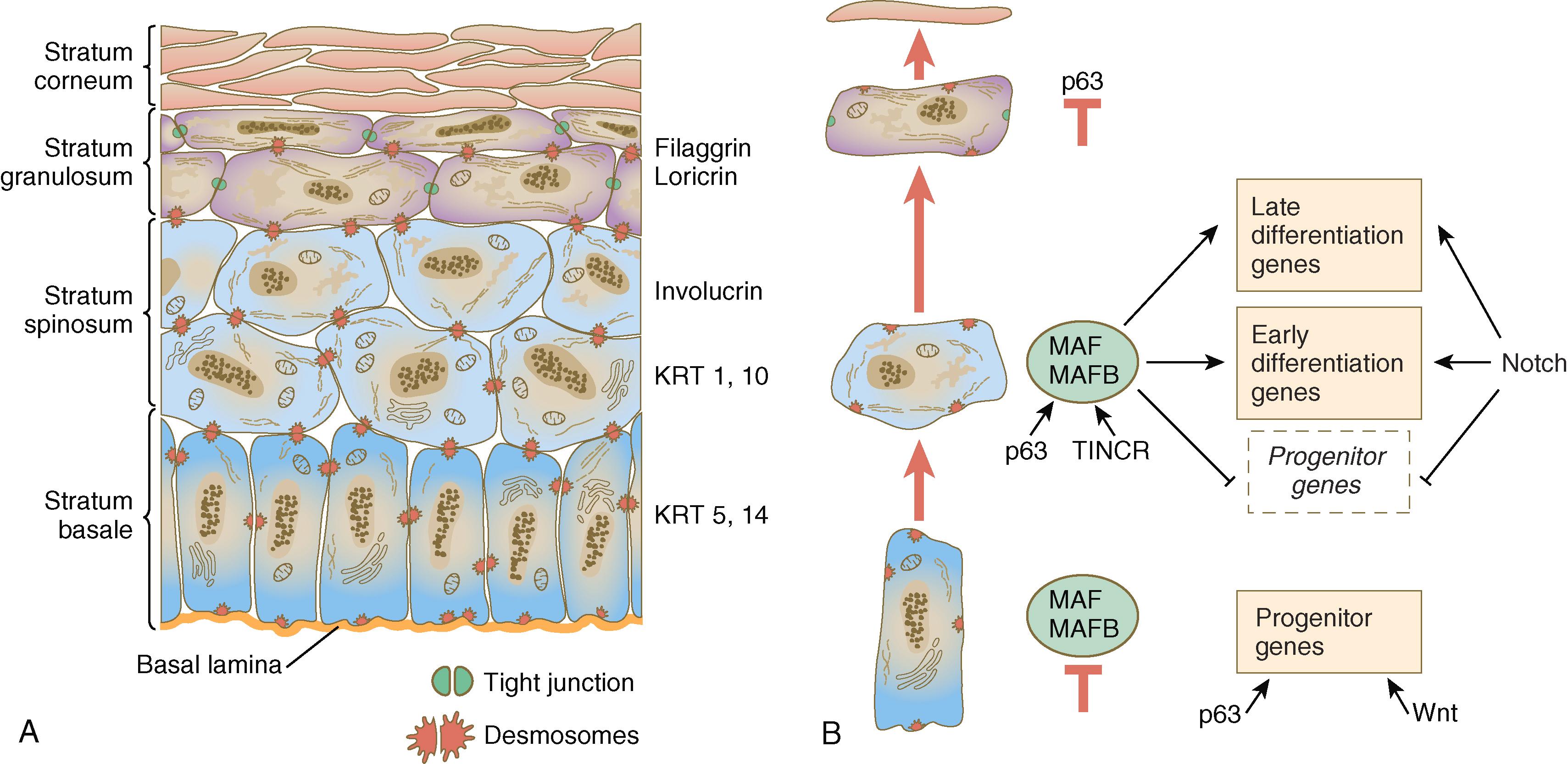
Keratohyalin granules , another marker of epidermal differentiation, begin to appear in the cytoplasm of the outer, postmitotic cells of the stratum spinosum and are prominent components of the stratum granulosum. Keratohyalin granules are composed of two types of protein aggregates—one histidine rich and one sulfur rich—closely associated with bundles of keratin filaments. Because of their high content of keratin, epidermal cells are given the generic name keratinocytes . As the keratinocytes move into the stratum granulosum, their nuclei begin to show characteristic signs of terminal differentiation, such as a flattened appearance, dense masses of nuclear chromatin, and early signs of breaking up of the nuclear membrane. In these cells, the bundles of keratin become more prominent, and the molecular weights of keratins that are synthesized are higher than in less mature keratinocytes.
As the cells move into the outer layer, the stratum corneum , they lose their nuclei and resemble flattened bags densely packed with keratin filaments. The cells of this layer are interconnected by the histidine-rich protein filaggrin , which is derived from one of the granular components of keratohyalin. Depending on the region of the body surface, the cells of the stratum corneum accumulate to form approximately 15 to 20 layers of dead cells. In postnatal life, whether through friction or the degradation of the desmosomes and filaggrin, these cells are eventually shed (e.g., approximately 1300 cells/cm 2 /h in the human forearm) and commonly accumulate as house dust.
For a number of functional reasons, the developing epidermis must form intercellular connections. Three types of connections form: (1) tight junctions, which form a planar barrier that prevents water loss; (2) desmosomes, which provide mechanical strength; and (3) adherens junctions, which also provide mechanical strength and other functions. The types and locations of these connections reflect the functional needs of the embryonic epidermis at specific times in its development.
Cells of the early single-layered ectoderm are attached to the underlying basal lamina and to one another. As the periderm forms, starting at the second month, this layer is strongly connected to the underlying layer of basal or intermediate cells, and the cells within the periderm are connected to their neighbors by tight junctions along their lateral surfaces. The absence of junctional complexes on the apical surfaces of peridermal cells may prevent abnormal fusion of epidermal cells within tissue folds. While the embryonic epidermis forms more layers, desmosomes and adherens junctions form on all surfaces of the cells of the stratum spinosum and stratum granulosum, which provides mechanical strength to the developing epidermis. Additionally, greater tight junction formation within the stratum granulosum creates a more efficient water barrier. By approximately 20 weeks, this barrier tips the balance between an epidermis more permeable to amniotic fluid to one that is essentially impermeable (see p. 117). At the final stages of their differentiation within the stratum corneum, epidermal cells lose their desmosomal junctions and their filaggrin connections, and they are ready to be shed into the amniotic fluid.
Biochemical work has correlated the expression of keratin proteins with specific stages of epidermal differentiation. Keratins K5, K14, and K15 are expressed in the basal layer, but as the stratum spinosum develops, the cells in that layer express K1 and K10. Loricrin and filaggrin, an intracellular binding protein, appear while the stratum granulosum and the stratum corneum develop in the early fetus.
Differentiation of the epidermis involves the participation of a large number of transcription factors and growth factors (see Figure 9.3B ). In essence, the first step is the activation of progenitor genes that generate an epithelial layer (the stratum basale). One of the most important of these is p63, a master regulator of epidermal commitment, but along with activation of p63 is the concomitant inhibition of a set of transcription factors (MAF and MAFB), which promote epidermal differentiation. Progression of cells from the stratum basale to the stratum spinosum requires turning off epidermal progenitor genes and turning on the epidermal differentiation genes MAF/MAFB . Through the activity of p63, the combined actions of the MAF/MAFB transcription factors and Notch signaling bring about these changes. Terminal differentiation, which carries the epidermal cells from the stratum granulosum to the stratum corneum, requires turning off the activity of p63 (through the action of a microRNA miR-203 ) within the cells of the stratum granulosum. With this change, the cells exit the cell cycle.
The proliferation of basal epidermal cells is under the control of a variety of growth factors. Some of these stimulate and others inhibit mitosis. Postnatally, keratinocytes commonly spend about 4 weeks in their passage from the basal layer of the epidermis to ultimate desquamation, but in some skin diseases, such as psoriasis , epidermal cell proliferation is poorly controlled, and keratinocytes may be shed within 1 week after their generation.
A prominent feature of the skin, particularly the thick skin of the palms and soles, is the presence of epidermal ridges and creases. On the tips of the digits, the ridges form loops and whorls in fingerprint patterns that are unique to the individual. These patterns form the basis for the science of dermatoglyphics , in which the patterns constitute the foundation for genetic analysis or criminal investigation.
The formation of epidermal ridges is closely associated with the earlier appearance of volar pads on the ventral surfaces of the fingers and toes ( Figure 9.4 ). Volar pads first form on the palms at approximately 6½ weeks, and by 7½ weeks, they have formed on the fingers. The volar pads begin to regress by approximately 10½ weeks, but while they are present, they set the stage for the formation of the epidermal ridges, which occurs between 11 and 17 weeks. Similar events in the foot occur approximately 1 week later than those in the hand.
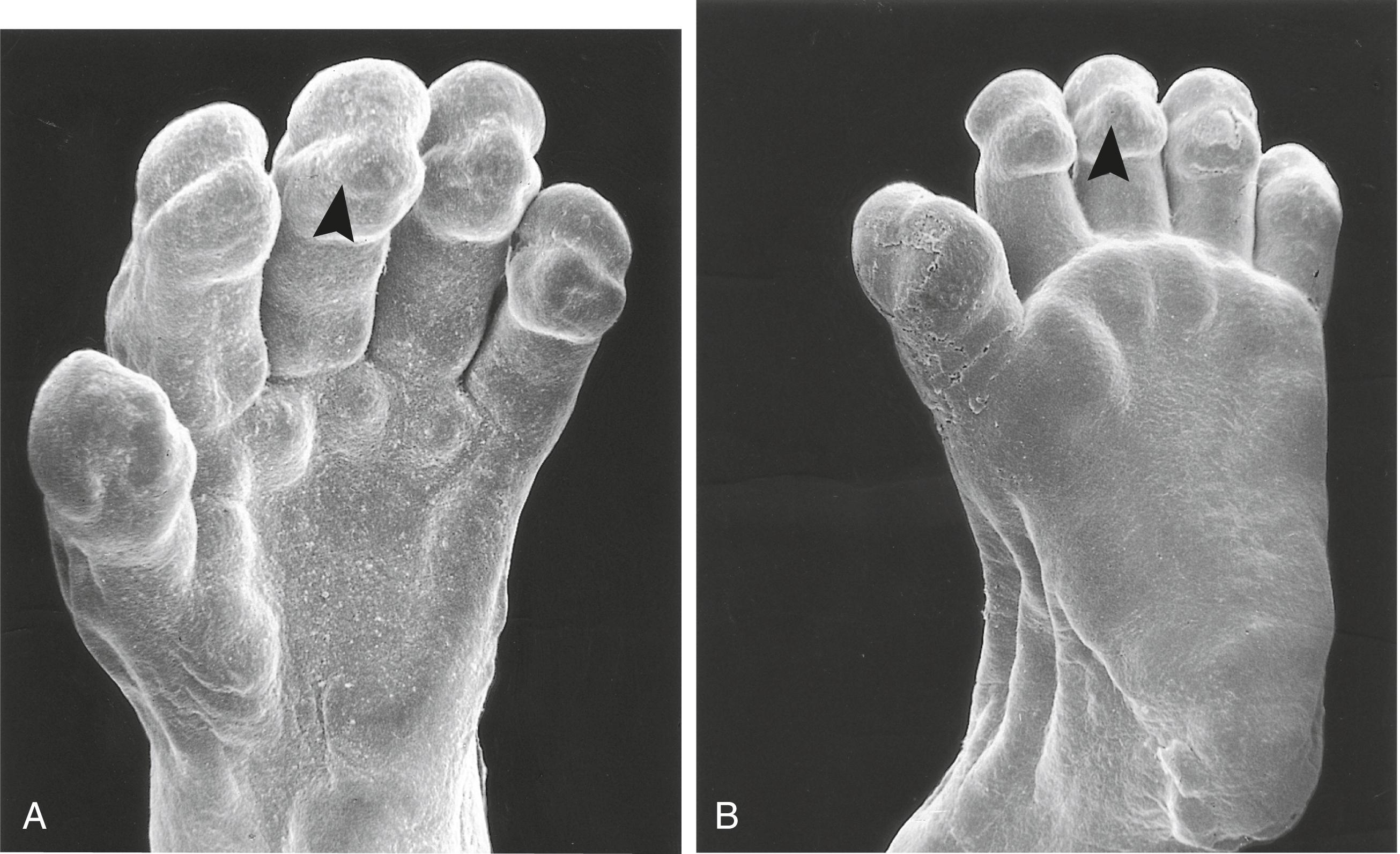
The pattern of the epidermal ridges is correlated with the morphology of the volar pads when the ridges first form. If a volar pad is high and round, the epidermal ridges form a whorl; if the pad is low, an arch results. A pad of intermediate height results in a loop configuration of the digital epidermal ridges. The timing of ridge formation also seems to influence the morphology. Early formation of ridges is associated with whorls, and late formation is associated with arches. The primary basis for dermatoglyphic patterns is still not understood.
When the epidermal ridges first form, the tips of the digits are still smooth, and the fetal epidermis is covered with peridermal cells. Beneath the smooth surface, however, epidermal and dermal ridges begin to take shape ( Figure 9.5 ). Late in the 5th month of pregnancy, the epidermal ridges become recognizable features of the surface landscape.
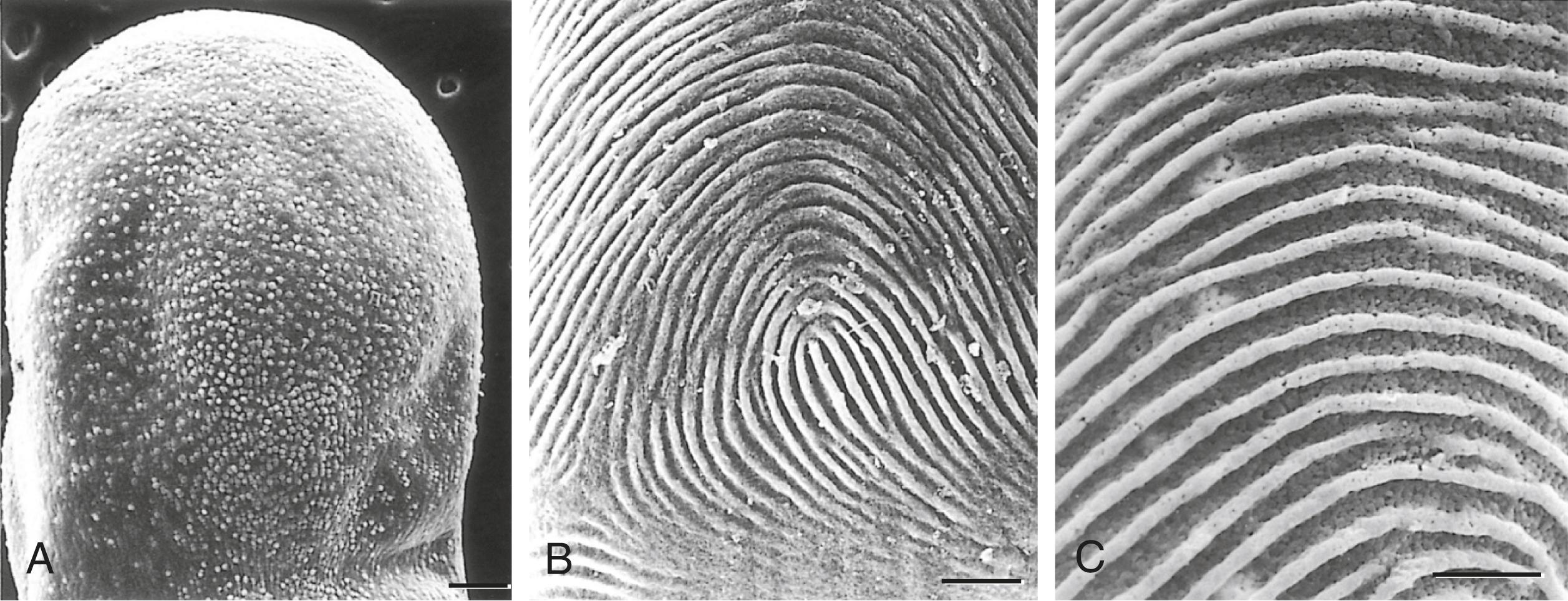
The dermis arises from several sources. In the trunk, dorsal dermis arises from the dermatome of the somites, whereas ventral and lateral dermis and dermis of the limbs are derived from the lateral plate mesoderm. In the face and much of the cranial skin and anterior neck, dermal cells are descendants of cranial neural crest ectoderm (see Figure 12.10 ).
Ectodermal Wnt signaling, acting through the β-catenin pathway, specifies the dermomyotomal cells and mesenchymal cells of the ventral somatopleure closest to the ectoderm, to become dermal cells, which express the dermal marker, Dermo 1 (see Figure 9.8A ). The future dermis is initially represented by loosely aggregated mesenchymal cells that are highly interconnected by focal tight junctions on their cellular processes. These early dermal precursors secrete a watery intercellular matrix rich in glycogen and hyaluronic acid.
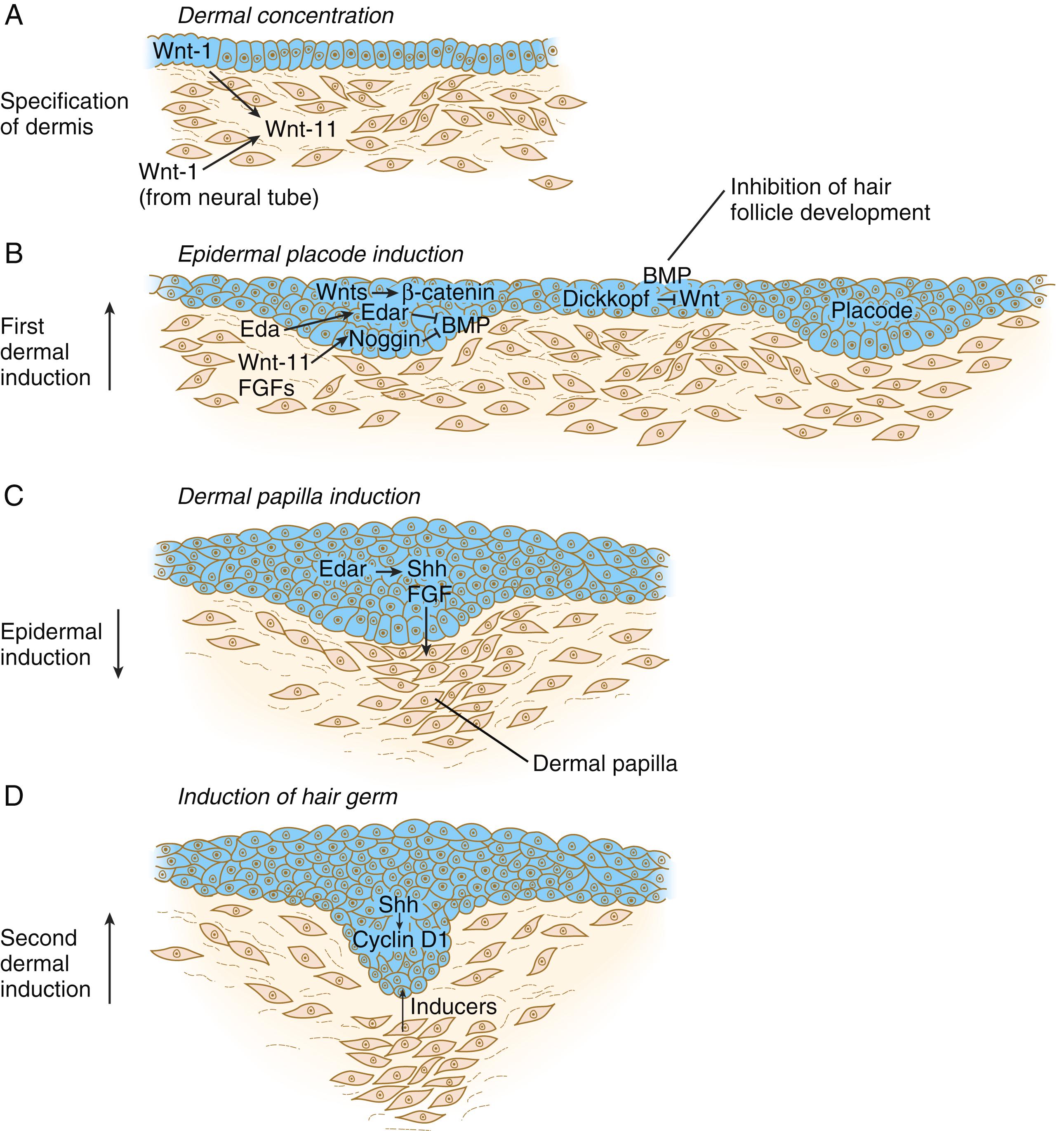
Early in the third month, the developing dermis undergoes a transition from the highly cellular embryonic form to a state characterized by the differentiation of the mesenchymal cells into fibroblasts and the formation of increasing amounts of a fibrous intercellular matrix. The principal types of fibers are types I and III collagen and elastic fibers. The dermis becomes highly vascularized, with an early capillary network transformed into layers of larger vessels. Shortly after the eighth week, sensory nerves growing into the dermis and epidermis help complete reflex arcs and thus allow the fetus to respond to pressure and stroking.
A multipotent population of mesenchymal cells within the embryonic dermis gives rise to a remarkable number of mature cell types ( Table 9.1 ). Even within a given cell type, their position within the body, even in the adult, is represented by the expression of combinations of Hox and other transcription factors.
| Cell Type | Location |
|---|---|
| Papillary fibroblast | Papillary layer of dermis |
| Reticular fibroblast | Reticular layer of dermis |
| Intradermal preadipocyte | Reticular layer of dermis |
| Intradermal adipocyte | Hypodermis |
| Myofibroblast | Healing wounds |
| Arrector pili muscle cells | Attach to hair follicles |
| Dermal papilla | Base of hair follicle bulb |
| Mesenchymal stem cells | Various |
| Perivascular cells | Surround dermal microvessels |
The transformation of simple ectoderm into a multilayered epidermis depends on continuing inductive interactions with the underlying dermis. Dermal–epidermal interactions are also the basis for the formation of a wide variety of epidermal appendages and the appearance of regional variations in the structure of the epidermis. Early in development, the epidermis covering the palms and soles becomes significantly thicker than the epidermis elsewhere on the body. These regions also do not produce hairs, whereas hairs of some sort, whether coarse or extremely fine, form in regular patterns from the epidermis throughout most of the rest of the body.
Tissue recombination experiments on a variety of vertebrate species have shown that the underlying dermis determines the course of development of the epidermis and its derivatives and that the ectoderm also influences the developmental course of the dermis. If the early ectodermal and mesenchymal components of the skin are enzymatically dissociated and grown separately, the ectodermal component remains simple ectoderm without differentiating into a multilayered epidermis with appropriate epidermal appendages. Similarly, isolated subectodermal mesenchyme retains its embryonic character without differentiating into dermis.
Classical experiments showed that if ectoderm from one part of the body is combined with dermis from another area, the ectoderm differentiates into a regional pattern characteristic of underlying dermis, rather than a pattern appropriate for the site of origin of the ectoderm ( Figure 9.6 ). Cross-species recombination experiments have shown that even in distantly related animals skin ectoderm and mesenchyme can respond to each other’s inductive signals. Dermal mesenchyme can even transform amniotic epithelium into hair-bearing skin.
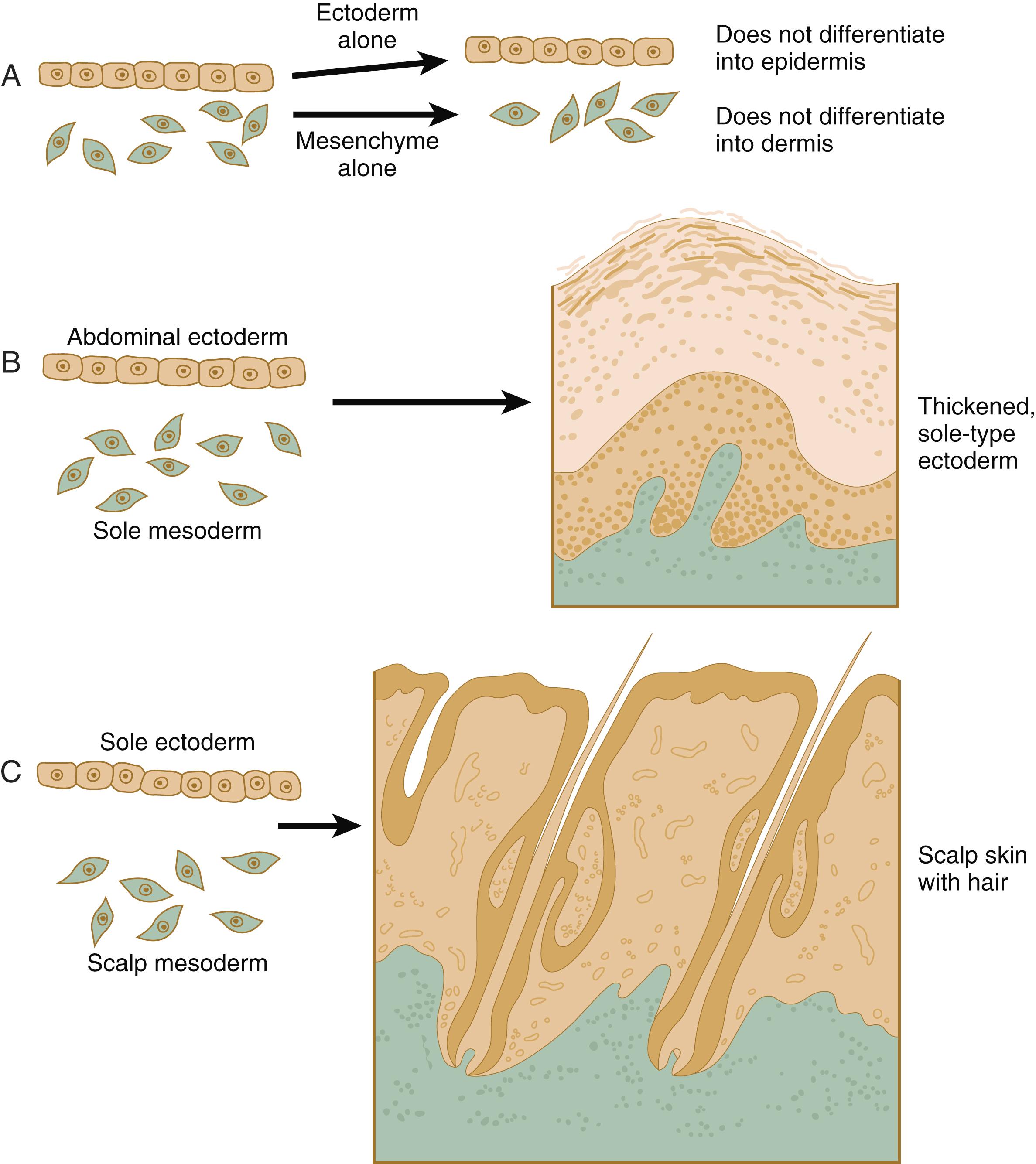
Contemporary research has shown that there are many nuances to the results obtained by the classical tissue recombination experiments. One of the most important new insights is the precision of the molecular controls that underlie the regional morphogenesis of both the epidermis and its derivatives. For example, whether skin on the hand consists of the thick palmar type or the thin skin of the back of the hand depends upon the combined actions of large numbers of transcription factors and signaling molecules that not only specify whether the skin will be dorsal or ventral but also whether it will be distal versus proximal limb skin. Combinations of Hox genes are part of the mix. The characteristics of the epidermal appendages, e.g., hairs, reflect the morphogenetic information inherent mainly in the dermis. Mutations in several genes are now known to result in abnormalities of either hair type or pattern. Patterning of hairs follows general gradients, with that of the head and trunk preceding that of the limbs. Even in the adult, dermal fibroblasts retain a permanent memory of their position within the body. If a cluster of dermal fibroblasts is combined with a layer of epidermal cells, they instruct the epidermis to produce appendages appropriate for the location from which the fibroblasts were derived.
As a result of inductive influences by the dermis, the epidermis produces a wide variety of appendages, such as hair, nails, sweat and sebaceous glands, mammary glands, and the enamel component of teeth. A common feature for several of these appendages is the presence of a condensation of mesenchymal cells underlying an ectodermal downgrowth. These two interacting components form the cellular basis for the development of the appendages.
(The development of teeth is discussed in Chapter 14 .)
Hairs are specialized epidermal derivatives that arise as the result of inductive stimuli from the dermis. There are many types of hairs, ranging from the coarse hairs of the eyelashes and eyebrows to the barely visible hairs on the abdomen and back. Regional differences in morphology and patterns of distribution are imposed on the epidermis by the underlying dermis.
Hair formation is first recognizable at about the twelfth week of pregnancy as regularly spaced epidermal placodes associated with small condensations of dermal cells called dermal papillae ( Figure 9.7 ). Under the continuing influence of a dermal papilla, the placode forms an epidermal downgrowth ( hair germ ), which over the next few weeks forms an early hair peg . In succeeding weeks, the epidermal peg overgrows the dermal papilla, and this process results in the shaping of an early hair follicle . At this stage, the hair follicle still does not protrude beyond the outer surface of the epidermis, but in the portion of the follicle that penetrates deeply into the dermis, a bulge presages the formation of sebaceous glands , which secrete an oily skin lubricant ( sebum ). Arising during the 13th and 14th weeks as stem cells from the same set of precursors that give rise to the hair follicle itself, cells of the developing sebaceous gland are arranged as a gradient. The basal cells contain all the cellular machinery needed to produce sebum. While the cells mature, they rise up within the gland, and the nuclei become pyknotic. Finally the cells undergo lysis and the entire lysed cell, consisting mostly of sebum, is secreted along the hair to the outside of the epidermis. Products of the fetal sebaceous glands accumulate on the surface of the skin as vernix caseosa . This substance may serve as a protective coating for the epidermis, which is continually exposed to amniotic fluid.
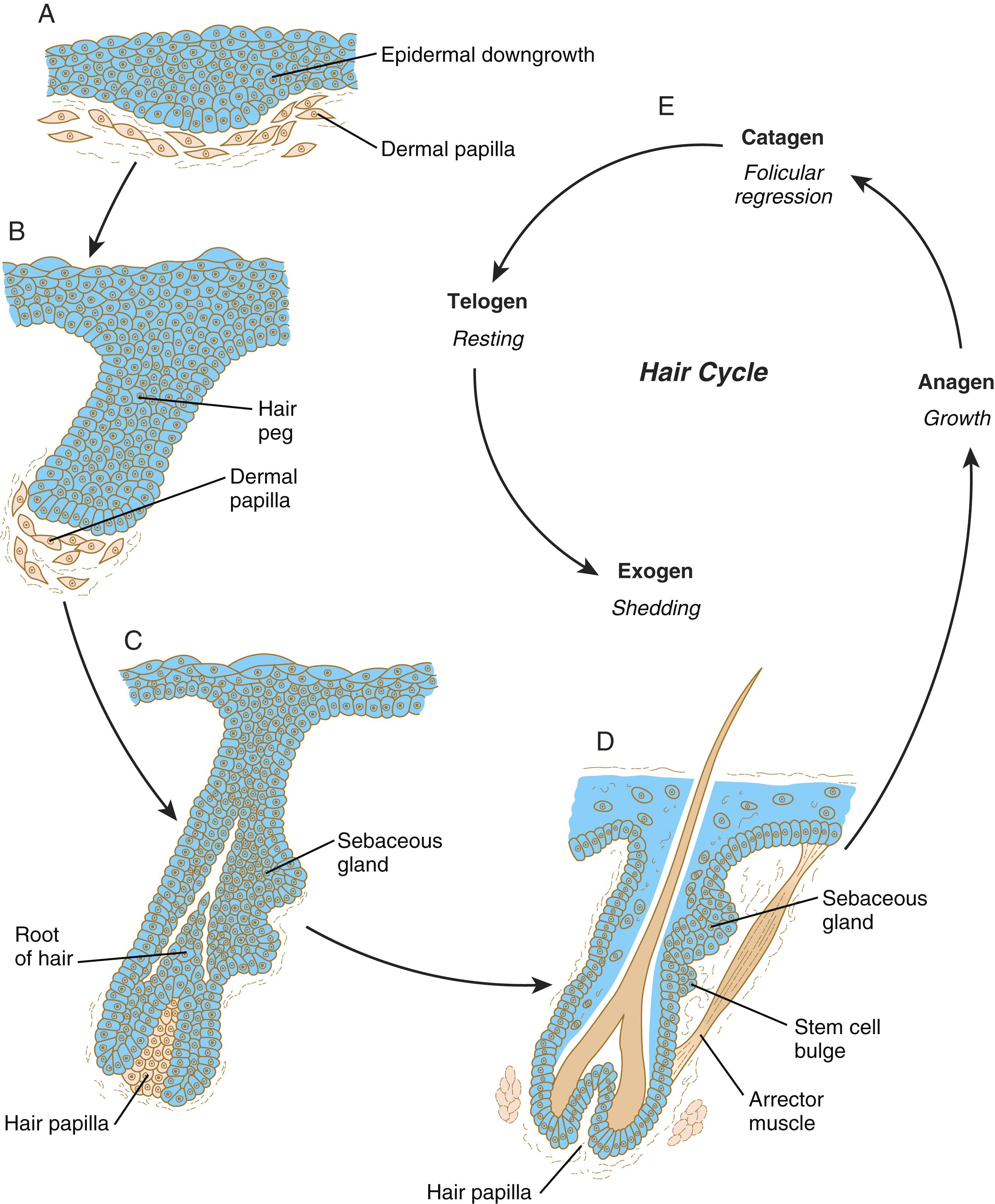
As the developing hair matures, a second small bulge below the sebaceous gland marks an aggregation of epidermal stem cells ( Figure 9.7D ), which persist throughout the life of the hair. The stem cell bulge serves as an attachment site for the tiny arrector pili muscle . The arrector pili is a mesodermally derived smooth muscle that lifts the hair to a nearly vertical position in a cold environment. In many animals, this increases the insulation properties of the hair. The developing hair follicle induces the adjacent dermal mesoderm to form the smooth muscle cells of this muscle. Specifically, a matrix molecule, called nephronectin , in the basement membrane covering the bulge induces the differentiation of neighboring mesenchymal cells into smooth muscle cells and then serves at the attachment site between the arrector pili muscle and the hair follicle.
The formation of a hair involves a series of inductive interactions mediated by signals that are only partly understood. When a dense condensation of dermal cells has formed beneath the ectoderm ( Figure 9.8A ), the first of two dermal inductions results in the thickening of ectoderm in very regularly arranged locations to form epidermal placodes ( Figure 9.8B ). Fibroblast growth factor (FGF) and Wnt (mainly Wnt-11) signaling from the dermis, along with the inactivation of local bone morphogenetic proteins (BMPs), stimulate the activation of other Wnts in the ectoderm to form an epidermal placode. The response of the ectoderm is to produce other Wnts, acting through β-catenin intermediates, and Edar , the receptor for the signaling molecule ectodysplasin (Eda) . In the areas where hairs will not develop (interfollicular areas), placode formation is inhibited by locally produced BMPs. How the epidermal placodes are spaced in such a geometrically regular fashion is still not well understood, but a balance of lateral stimulation by Wnts and their subsequent inhibition by Dickkopf appears to play an important role.
The newly formed epidermal placodes then become the inducing agent and stimulate the aggregation of mesenchymal cells beneath the placode to form the dermal papilla ( Figure 9.8C ). Sonic hedgehog and FGF, produced by the epidermal placode, are involved in the epidermal signal that stimulates the condensation of dermal mesenchymal cells to form the dermal papilla.
Next, the dermal papilla initiates the second dermal induction by stimulating downgrowth of the cells of the epidermal placode into the dermis ( Figure 9.8D ). Epidermal downgrowth, which involves considerable epidermal cellular proliferation, is stimulated by expression of sonic hedgehog by the epidermal cells and the subsequent expression of cyclin D1, part of the cell cycling pathway. Later formation of a hair is structurally and biochemically an extremely complex process, which, among other things, involves the expression of a range of Hox genes in specific locations and at specific times along the length of each developing hair.
Once formed, an individual hair follows a regular cycle of growth and shedding (see Figure 9.7 ). During anagen , the first phase in the cycle, the hair is actively growing (around 10 cm per year). This phase can last as long as 5 to 6 years. The duration of the growth phase, and consequently the length of the hair, is regulated by FGF-15. The hair then enters catagen , a phase lasting 1 or 2 weeks, during which the hair follicle regresses to only a fraction of its original length. The hair stops growing in the resting phase ( telogen ), which lasts 5 to 6 weeks, after which the hair is shed ( exogen ). Adjacent hairs are frequently in different phases of the hair cycle.
Erupted hairs are first seen on the eyebrows shortly after 16 weeks. Within a couple of weeks, hairs cover the scalp. The eruption of hairs follows a cephalocaudal gradient over the body. During the later stages of hair formation, the hair bulb becomes infiltrated with melanocytes, which provide color to the hair. Starting around the fifth month, the epidermal cells of the hair shaft begin to undergo keratinization, forming firm granules of trichohyalin , which imparts hardness to the hair.
The first fetal hairs are very fine in texture and are close together. Known as lanugo , they are most prominent during the seventh and eighth months. Lanugo hairs are typically shed just before birth and are replaced by coarser definitive hairs, which arise from newly formed follicles.
The pattern of epidermal appendages such as hairs has been shown experimentally to relate to patterns generated in the dermis. Other studies have compared patterns of scalp hairs between normal embryos and embryos with cranial malformations ( Figure 9.9 ) and have shown a correlation between whorls and the direction of hair growth and the tension on the epidermis at the time of formation of the hair follicles. The cross-sectional shape of individual hairs determines the physical characteristics of the hair. Perfectly round hairs are straight. As hairs go from oval to more flattened in cross-section, they progress along a spectrum from wavy to curly to kinky.
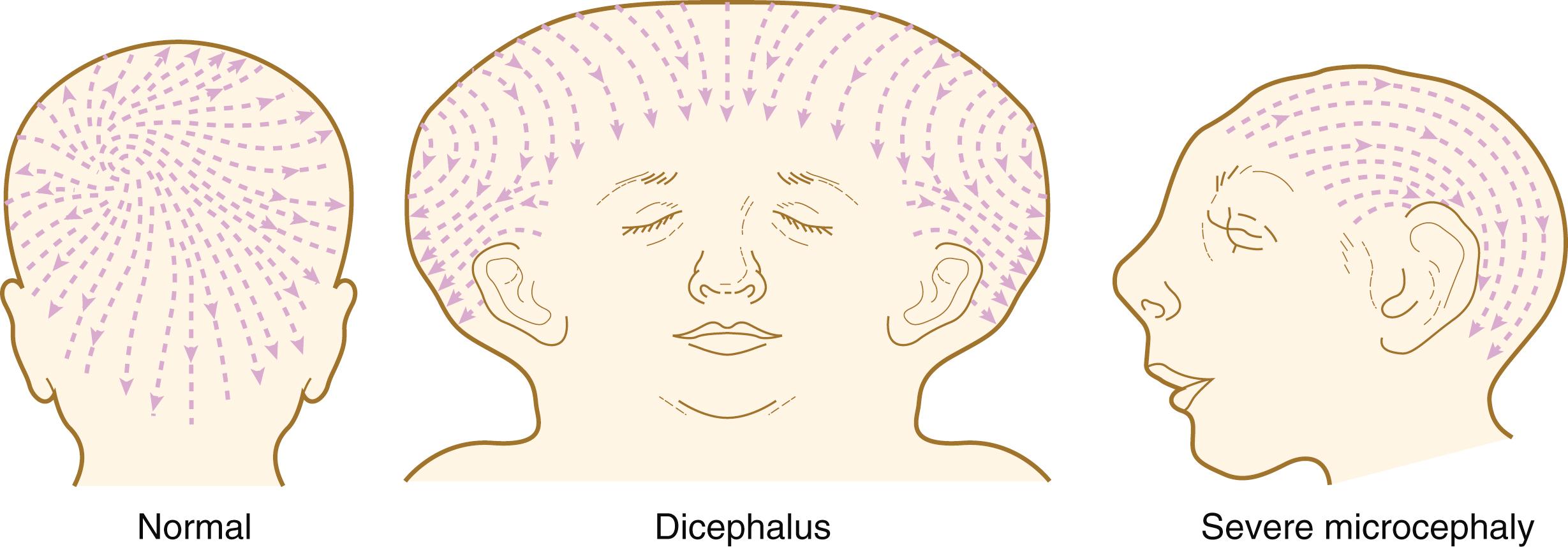
Eccrine sweat glands , like hairs, take the form of nonbranching cellular downgrowths into the dermis from the lower layer of ectoderm. Starting at approximately 17 weeks, the formation of hair follicles is reduced and activity shifts to the formation of sweat glands, although primordia of the first sweat glands appear as early as 13 weeks. Both sweat glands and hairs arise from ectodermal placodes that have the potential to form either type of structure. Which way they develop depends the local signaling environment. Hairs form when BMP signaling in the mesenchyme is inhibited, allowing shh signaling. On the other hand, if local mesenchymal BMP and FGF is stimulated, shh signaling is suppressed, and sweat gland formation is specified.
In most mammals, hairs and sweat glands are found in separate locations, whereas in humans, they often intermingle. In nonhuman mammals, the different signaling environments leading to hair or sweat gland formation are spatially segregated. In humans, however, there is a temporal segregation so that at one time in the same area, high shh levels stimulate the formation of hairs, and at a later time (17 weeks) the local suppression of shh by high levels of BMP stimulates the formation of sweat glands ( Figure 9.10 ). Eccrine sweat glands first appear on the palms and soles and then spread throughout the body as embryonic development progresses.
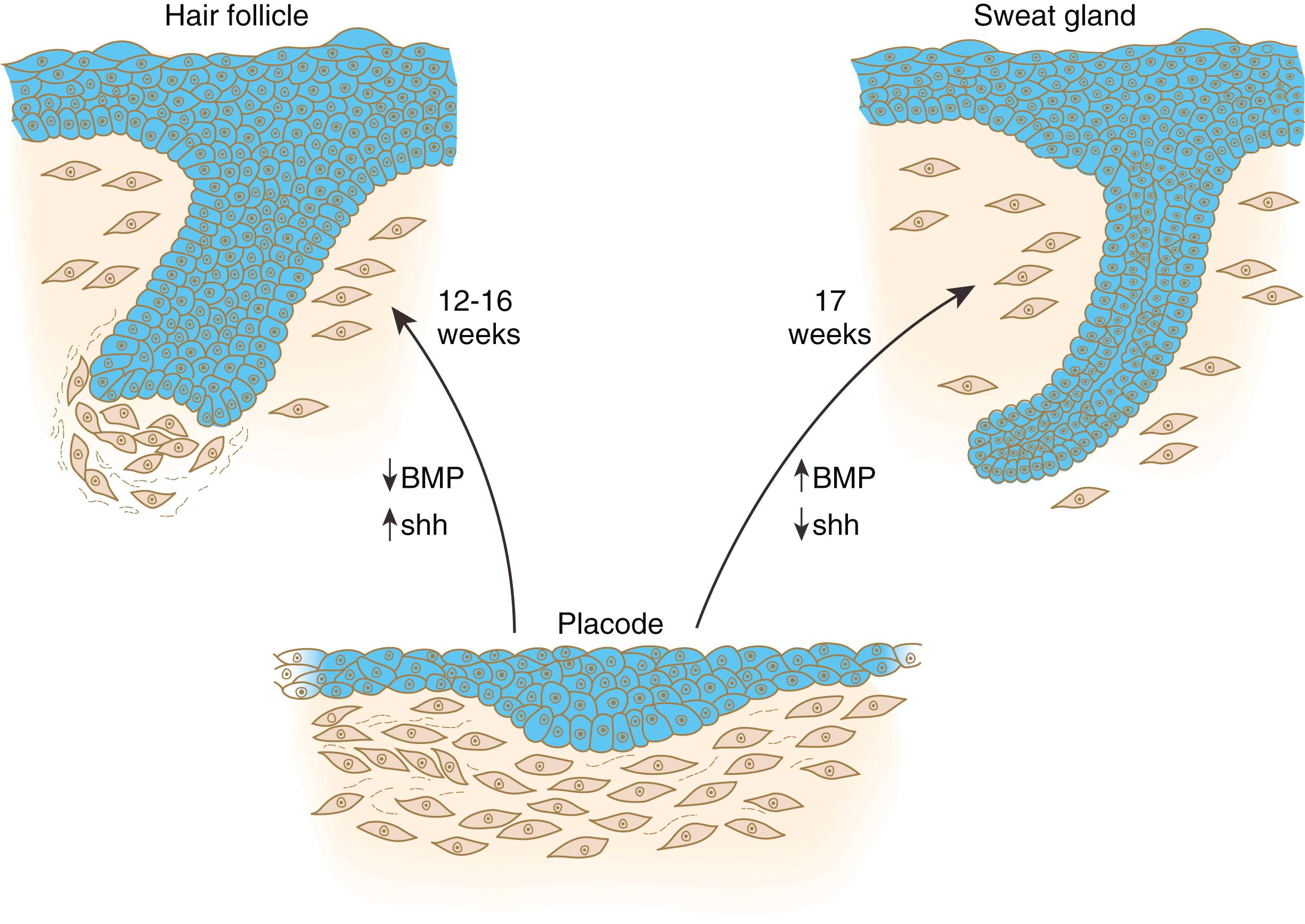
Apocrine sweat glands , which produce an oily secretion that is metabolized by bacteria to produce the characteristic odor of sweat, originate in association with developing hair follicles in the axillary, pubic, and perianal regions. Little is known about how they develop.
During the tenth week, epidermal thickenings ( primary nail field ) on the dorsal surfaces of the digits mark the beginnings of nail development. Following the overall plan of limb development, nails form on the dorsal surfaces of the digits. If the molecular plan for dorsoventral axis formation in the limb (see p. 202) is disturbed, nails can either be duplicated or missing. Both Wnt and BMP signaling are important to differentiate the epidermal cells that form the nail. Cells from the primary nail field expand proximally to undercut the adjacent epidermis ( Figure 9.11 ). Proliferation of cells in the proximal part of the nail field results in the formation of a matrix primordium , which gives rise to the nail plate that grows distally to cover the nail bed . The nail plate itself consists of highly keratinized epidermal cells. A thin epidermal layer, the eponychium , initially covers the entire nail plate, but it eventually degenerates, except for a thin persisting rim along the proximal end of the nail. The thickened epidermis underlying the distalmost part of the nail is called the hyponychium , and it marks the border between dorsal and ventral skin. Outgrowing fingernails reach the ends of the digits by approximately 32 weeks, whereas in toenails, this does not occur until 36 weeks ( Figure 9.12 ).
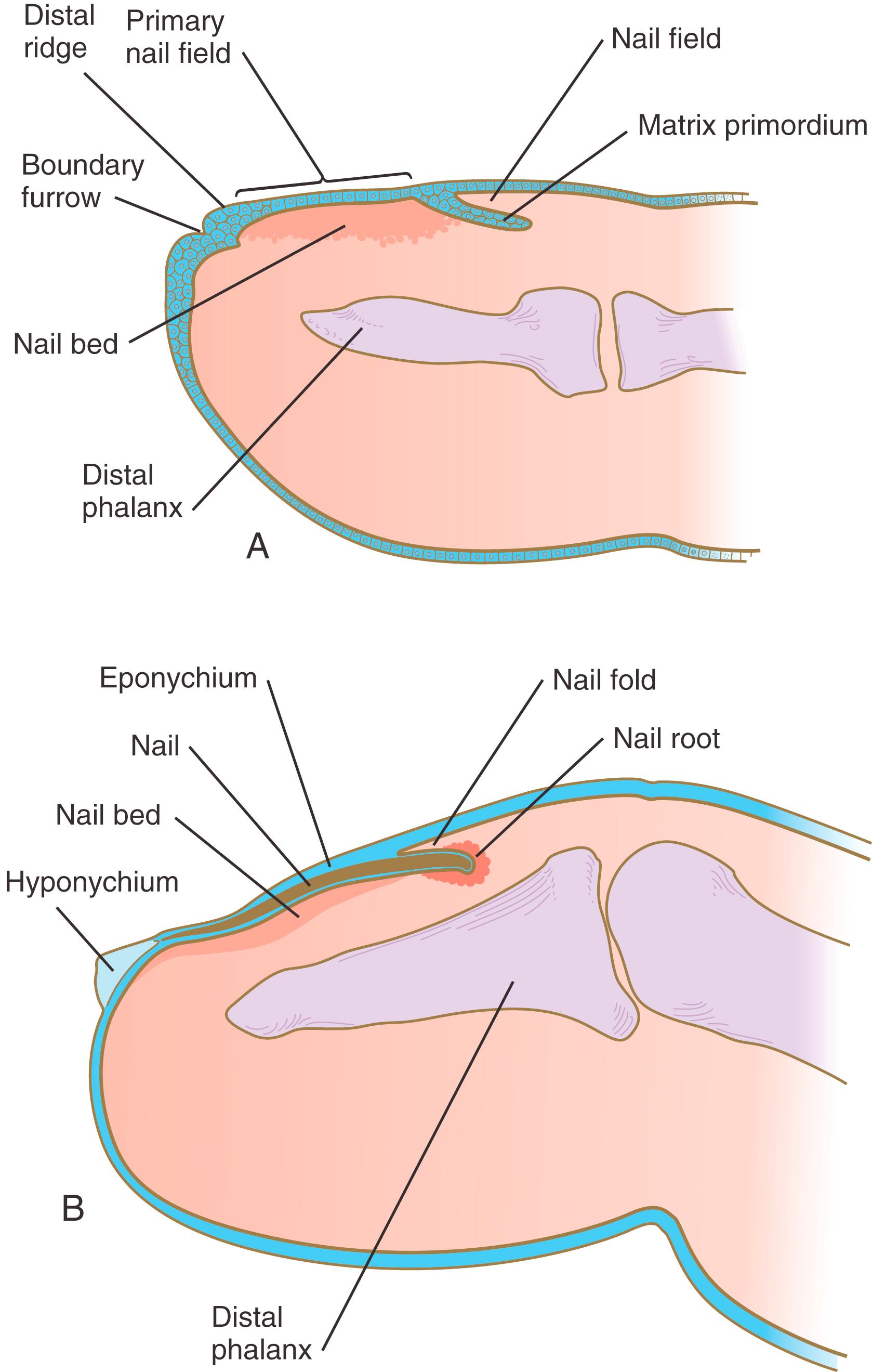
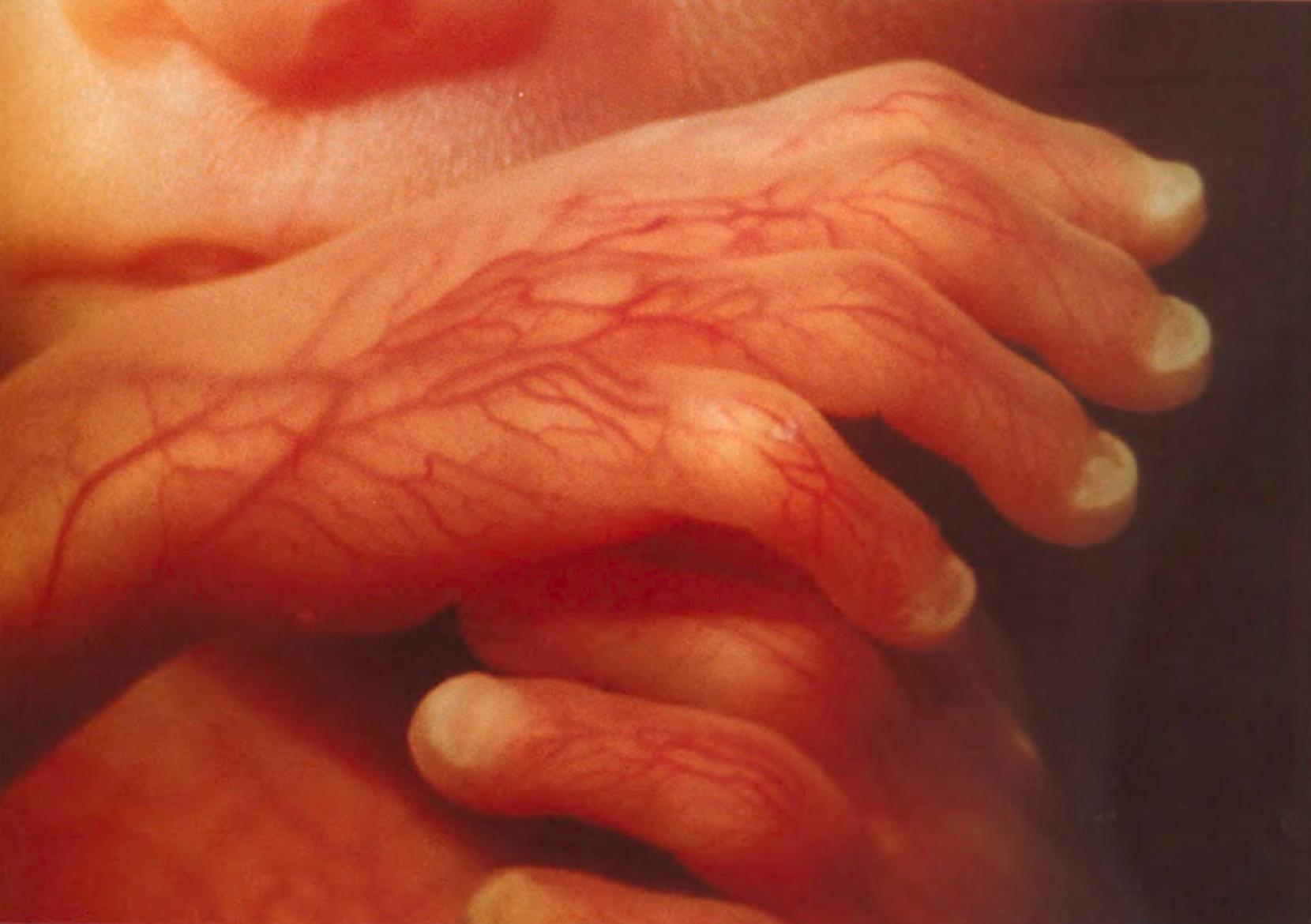
As with many glandular structures, the mammary glands arise as epithelial (in this case, ectodermal) downgrowths into mesenchyme in response to inductive influences by the mesenchyme. The first morphological evidence of mammary gland development is the appearance of two bands of ectodermal thickenings called milk lines (part of the wolffian ridge [see p. 112]) running along the ventrolateral body walls in embryos of both genders at approximately 6 weeks ( Figure 9.13A ). The dorsoventral location of the milk lines is guided in part by interactions between FGF signaling arising from the somites and a ventral inhibitory BMP influence. The milk line is marked by the expression of the transcription factor Tbx3 and various Wnts . The thickened ectoderm of the milk lines undergoes fragmentation, and remaining areas form the primordia of the mammary glands. The craniocaudal level and the extent along the milk lines at which mammary tissue develops vary among species. Comparing the location of mammary tissue in cows (caudal), humans (in the pectoral region), and dogs (along the length of the milk line) shows the wide variation in location and number of mammary glands. In humans, supernumerary mammary tissue or nipples can be found anywhere along the length of the original milk lines ( Figure 9.13B ).

Individual mammary placodes form from ectodermal cells of the milk line. In contrast to hair and tooth placode formation, the migration and aggregation of milk line cells, rather than proliferation, is the dominant cellular mechanism leading to placode formation. The expression of Tbx3, which stimulates the Wnt/catenin pathway, is a dominant molecular mechanism in mammary placode formation.
Mammary ductal epithelial downgrowths ( Figure 9.14 ) are associated with two types of mesoderm: fibroblastic and the mammary fat pad precursor. The early epithelial downgrowth secretes parathyroid hormone–related hormone , which increases the sensitivity of the underlying mesenchymal cells to BMP-4 . BMP-4 signals within the underlying mesenchyme have two principal effects (see Figure 9.14B ). First, they stimulate further downgrowth of the mammary epithelial bud. Second, they stimulate the expression of the transcription factor Msx-2 , which inhibits the formation of hair follicles in the region of the nipple. Experimental evidence suggests that inductive interactions with the fatty component of the connective tissue are responsible for the characteristic shaping of the mammary duct system. As with many developing glandular structures, the inductive message seems to be mediated to a great extent by the extracellular matrix of the connective tissue.
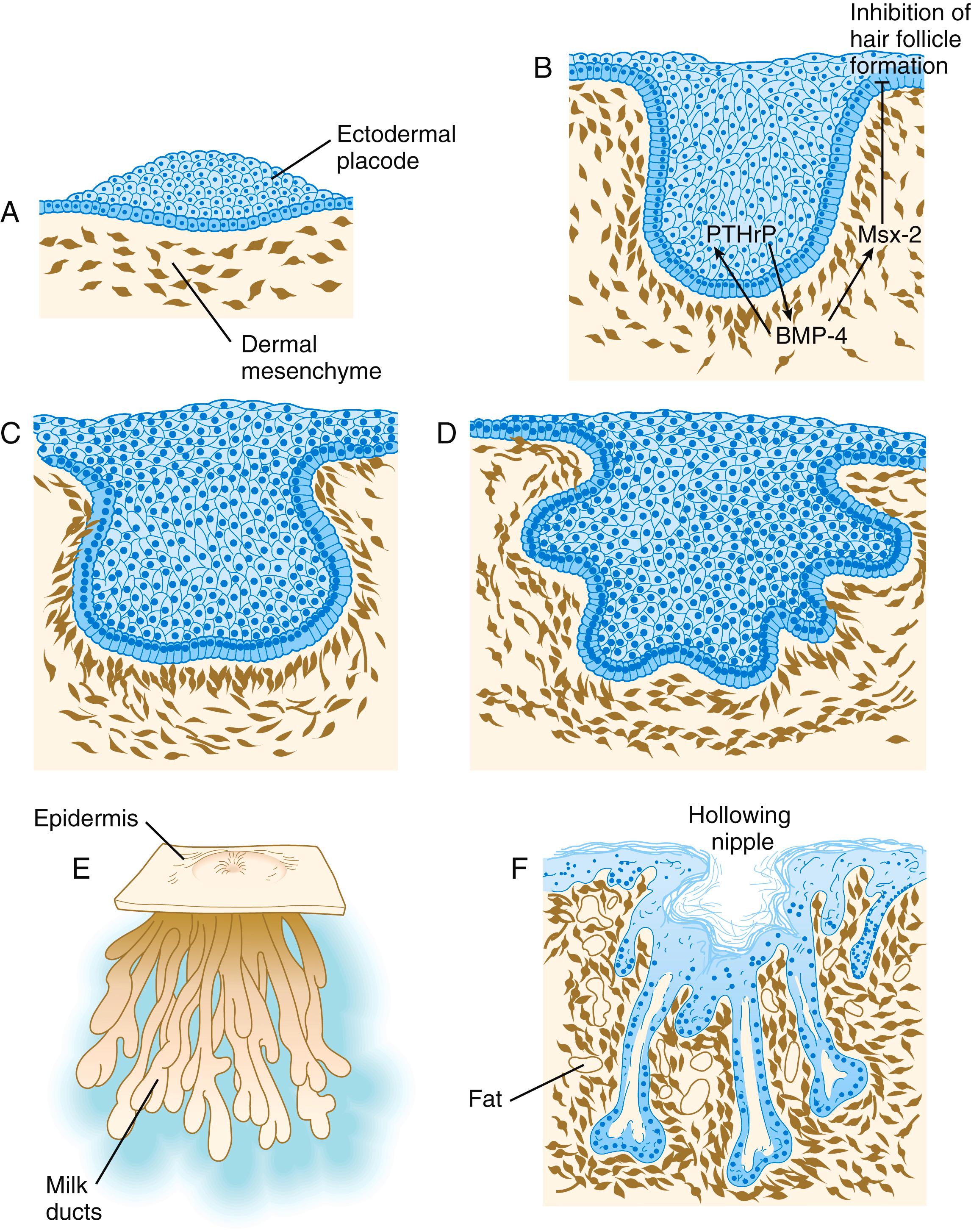
Elongation and branching of the early duct system are controlled by a large number of gene products, which are downstream of estrogen and growth hormone. For example, growth hormone acts on the mammary mesoderm to activate the release of insulinlike growth factor-1 (IGF-1), which then acts on the ductal epithelium via IGF-1 receptors.
Although the mesoderm controls the branching pattern of the ductal epithelium, the functional properties of the mammary ducts are intrinsic to the epithelial component. An experiment in which mouse mammary ectoderm was combined with salivary gland mesenchyme illustrates this point. The mammary ducts developed a branching pattern characteristic of salivary gland epithelium, but despite this, the mammary duct cells produced one of the milk proteins, α-lactalbumin.
In keeping with their role as secondary sexual characteristics, mammary glands are extremely responsive to the hormonal environment. This has been shown by experiments conducted on mice. In contrast to the continued downgrowth of ductal epithelium in female mice, the mammary ducts in male mice respond to the presence of testosterone by undergoing a rapid involution. Female mammary ducts react similarly if they are exposed to testosterone. Further analysis has shown that the effect of testosterone is mediated through the mammary mesenchyme, rather than acting directly on the ductal epithelium. Conversely, if male mammary ducts are allowed to develop in the absence of testosterone, they assume a female morphology. Mammary duct development in male humans does not differ from that in female humans until puberty. Even then, a rudimentary duct system remains, which is why men can develop gynecomastia or breast cancer in later life.
The role of the mesoderm and testosterone receptors is well illustrated in experiments involving mice with a genetic mutant, androgen insensitivity syndrome . This is the counterpart of a human condition called the testicular feminization syndrome , in which genetic male individuals lack testosterone receptors. Despite having high circulating levels of testosterone, female phenotypes, including typical female breast development, develop in these individuals ( Figure 9.15A ), because, without receptors, the tissue cannot respond to the testosterone.
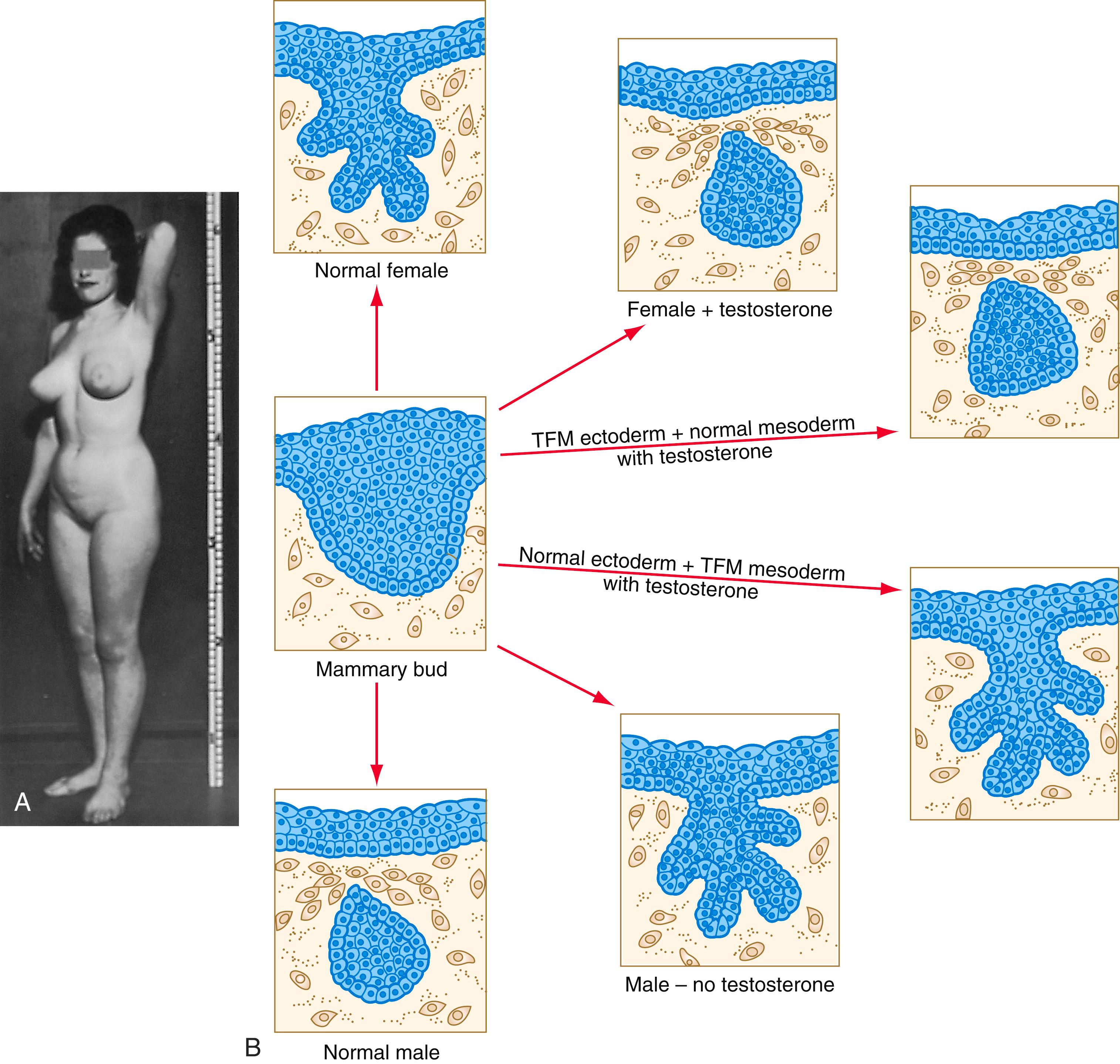
In vitro recombination experiments on mice with androgen insensitivity have been instrumental in understanding the role of the mesoderm in mediating the effects of testosterone on mammary duct development ( Figure 9.15B ). If mutant mammary ectoderm is combined with normal mesoderm in the presence of testosterone, the mammary ducts regress, but normal ectoderm combined with mutant mesoderm continues to form normal mammary ducts despite being exposed to high levels of testosterone. This shows that the genetic defect in testicular feminization is expressed in the mesoderm.
The postnatal development of female mammary gland tissue is also highly responsive to its hormonal environment. The simple mammary duct system that was laid down in the embryo remains in an infantile condition until it is exposed to the changing hormonal environment at the onset of puberty ( Figure 9.16A ). Increasing levels of circulating estrogens, acting on a base of growth hormone and insulin-like growth factor activity, stimulate the proliferation of the mammary ducts and enlargement of the pad of fatty tissue that underlie it ( Figure 9.16B ). As is the case with testosterone effects, estrogen effects on the epithelium of the mammary ducts are mediated via paracrine influences from the mammary connective tissue stroma, which contains the estrogen receptors.
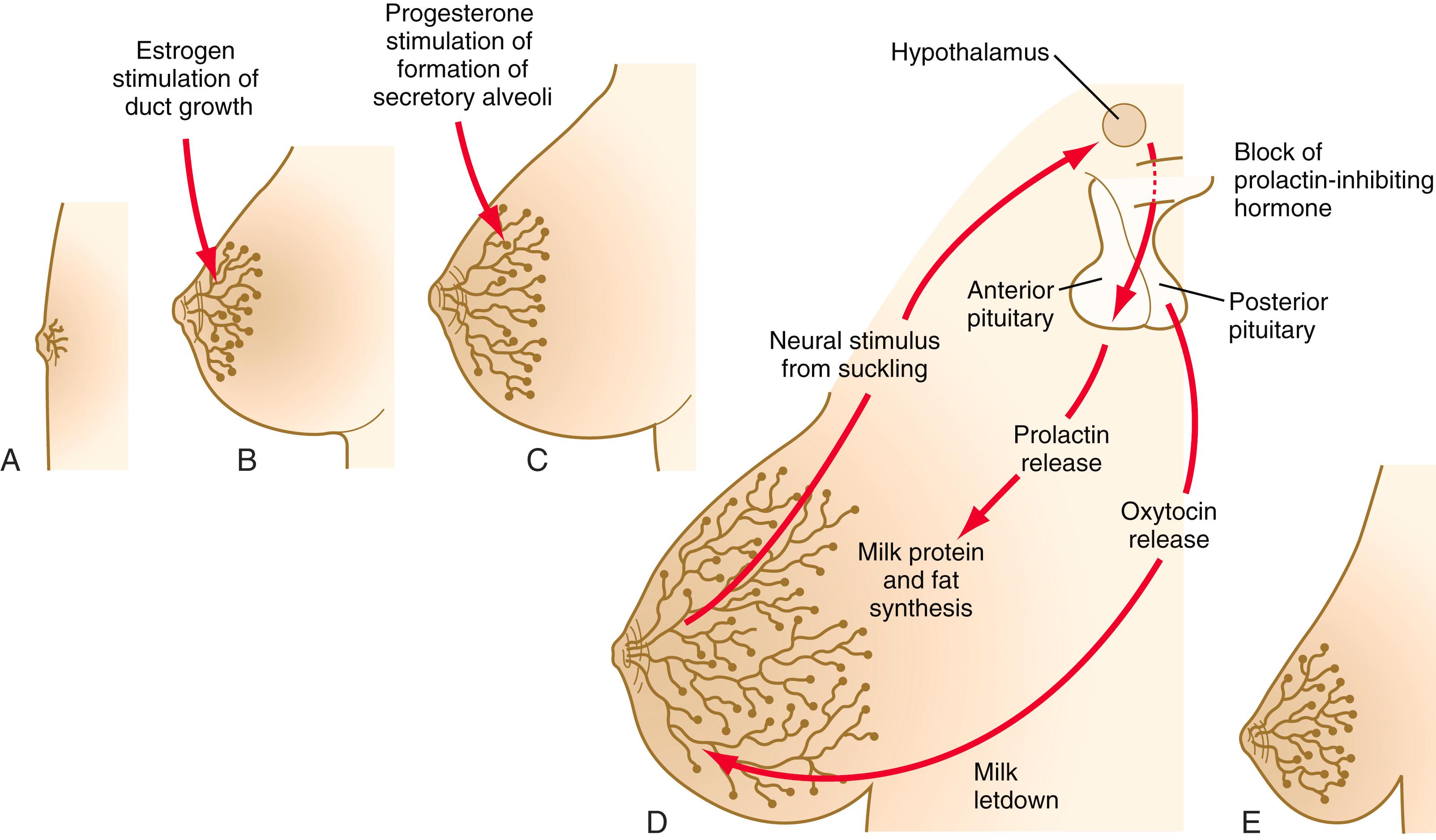
The next major change in the complete cycle of mammary tissue development occurs during pregnancy, although minor cyclical changes in mammary tissue are detectable in each menstrual cycle. During pregnancy, increased amounts of progesterone, along with prolactin and placental lactogen, stimulate the development of secretory alveoli at the ends of the branched ducts ( Figure 9.16C ). With continuing development of the alveoli, the epithelial cells build up increased numbers of the cytoplasmic organelles, such as rough endoplasmic reticulum and the Golgi apparatus, which are involved in protein synthesis and secretion.
Lactation involves numerous reciprocal influences between the mammary glands and the brain; these are summarized in Figure 9.16D . Stimulated by prolactin secretion from the anterior pituitary, the alveolar cells synthesize milk proteins ( casein and α-lactalbumin) and lipids. In a rapid response to the suckling stimulus, the ejection of milk is triggered by the release of oxytocin by the posterior portion of the pituitary. Oxytocin causes the contraction of myoepithelial cells , which surround the alveoli. These contractions squeeze milk from the alveoli into the duct system. Suckling also causes an inhibition of the release of luteinizing hormone–releasing hormone by the hypothalamus that results in the inhibition of ovulation and a natural form of birth control.
With cessation of nursing, reduced prolactin secretion and the inhibitory effects of nonejected milk in the mammary alveoli result in the cessation of milk production. The mammary alveoli regress, and the duct system of the mammary gland returns to the nonpregnant state ( Figure 9.16E ).
Clinical Correlation 9.1 summarizes several types of anomalies that affect the integumentary system.
Several types of anomalies affect the integumentary system. Ectodermal dysplasia is a germ layer defect that can affect many ectodermal derivatives depending on the type and severity of the condition. In addition to abnormalities of the epidermis itself, this syndrome can include the absence or abnormalities of hair and teeth (see Figure 8.22 ) and short stature (caused by anterior pituitary gland maldevelopment).
Numerous relatively rare conditions are included among the genetically transmitted disorders of keratinization. Ichthyosis is characterized by scaling and cracking of a hyperkeratinized epidermis. Disorders of sweat glands are commonly associated with this condition. A more severe autosomal recessive disorder is a harlequin fetus , in which epidermal platelike structures form, with deep cracks between the structures because the skin cannot expand to accommodate the increasing bulk of the fetus. Infants with this condition typically do not survive longer than a few weeks.
Many abnormalities of hair are known to have a genetic basis. These range from complete hair loss ( atrichia ), caused by mutations in the hairless gene (HR), to hypertrichosis , a condition characterized by excessive ectopic hair growth. Because of the complex structure and signal-calling within the hair follicle itself, mutations in a variety of genes underlie conditions involving fragility or abnormal structure of hairs themselves.
Several specific defects in the synthesis of types I and III collagen are lumped together as variants of the Ehlers-Danlos syndrome . Individuals with this condition typically have hypermobile joints. Affected skin can be characterized by sagging or hyperelasticity ( Figure 9.17 ).

Angiomas of the skin (birthmarks) are vascular malformations characterized by localized red or purplish spots ranging in size from tiny dots to formations many inches in diameter. Angiomas consist of abnormally prominent plexuses of blood vessels in the dermis, and they may be raised above the level of the skin or a mucous membrane (see Figure 17.53 ).
Skeletal tissue is present in almost all regions of the body, and the individual skeletal elements are quite diverse in morphology and tissue architecture. Despite this diversity, however, there are some fundamental embryological commonalities.
All skeletal tissue arises from cells with a mesenchymal morphology, but the origins of the mesenchyme vary in different regions of the body. In the trunk, the mesenchyme that gives rise to the segmented axial skeleton (i.e., vertebral column, ribs, sternum) originates from the sclerotomal portion of the mesodermal somites, whereas the appendicular skeleton (the bones of the limbs and their respective girdles) is derived from the mesenchyme of the lateral plate mesoderm.
The origins of the head skeleton are more complex. Some cranial bones (e.g., the bones making up the roof and much of the base of the skull) are mesodermal in origin, but the facial bones and some of the bones covering the brain arise from mesenchyme derived from the ectodermal neural crest.
The deep skeletal elements of the body typically first appear as cartilaginous models of the bones that will ultimately be formed ( Figures 9.18 and 9.19 ). At specific periods during embryogenesis, the cartilage is replaced by true bone through the process of endochondral ossification . In contrast, the superficial bones of the face and skull form by the direct ossification of mesenchymal cells without an intermediate cartilaginous stage ( intramembranous bone formation ). Microscopic details of intramembranous and endochondral bone formation are presented in standard histology texts and are not repeated here.
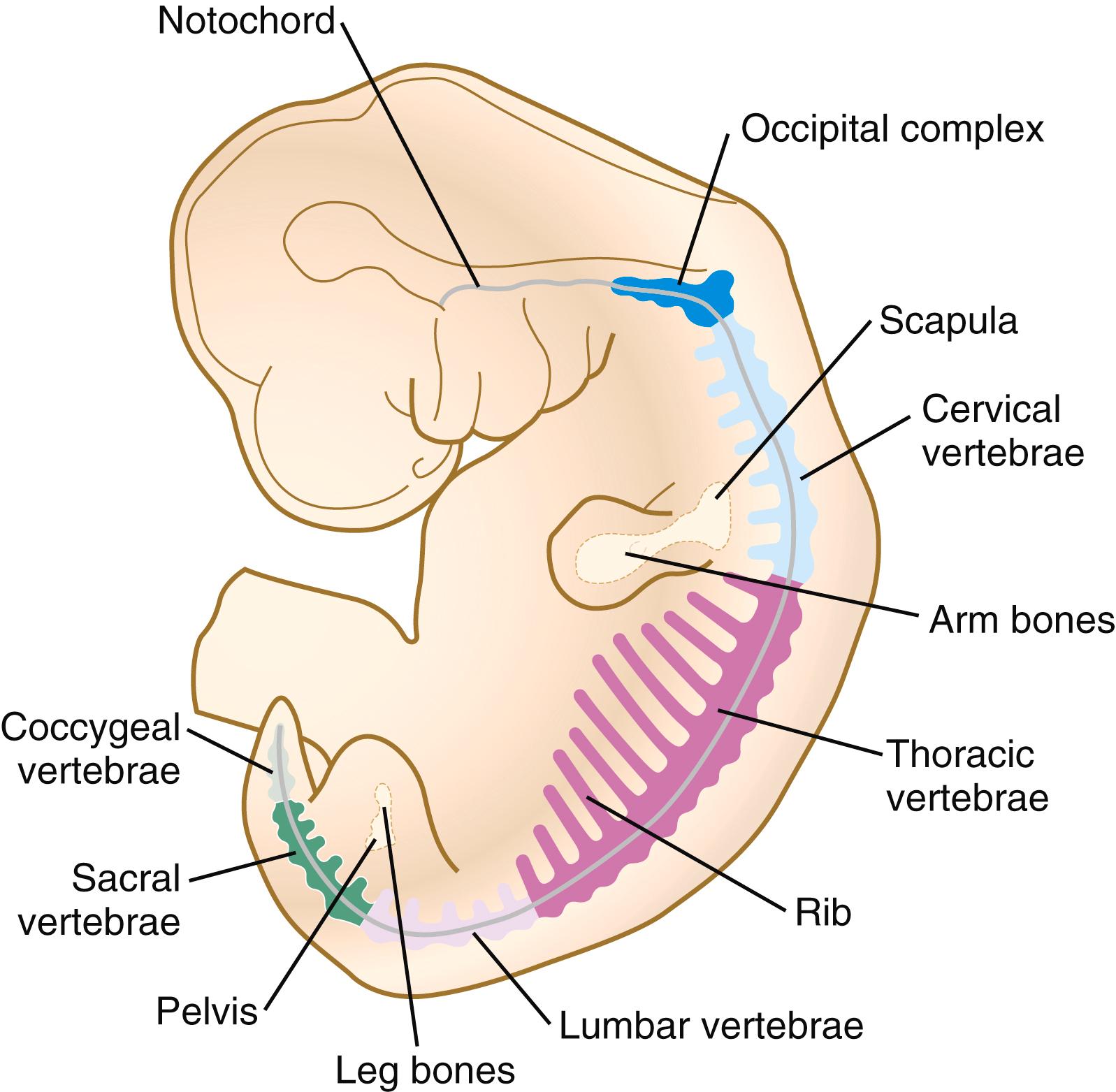
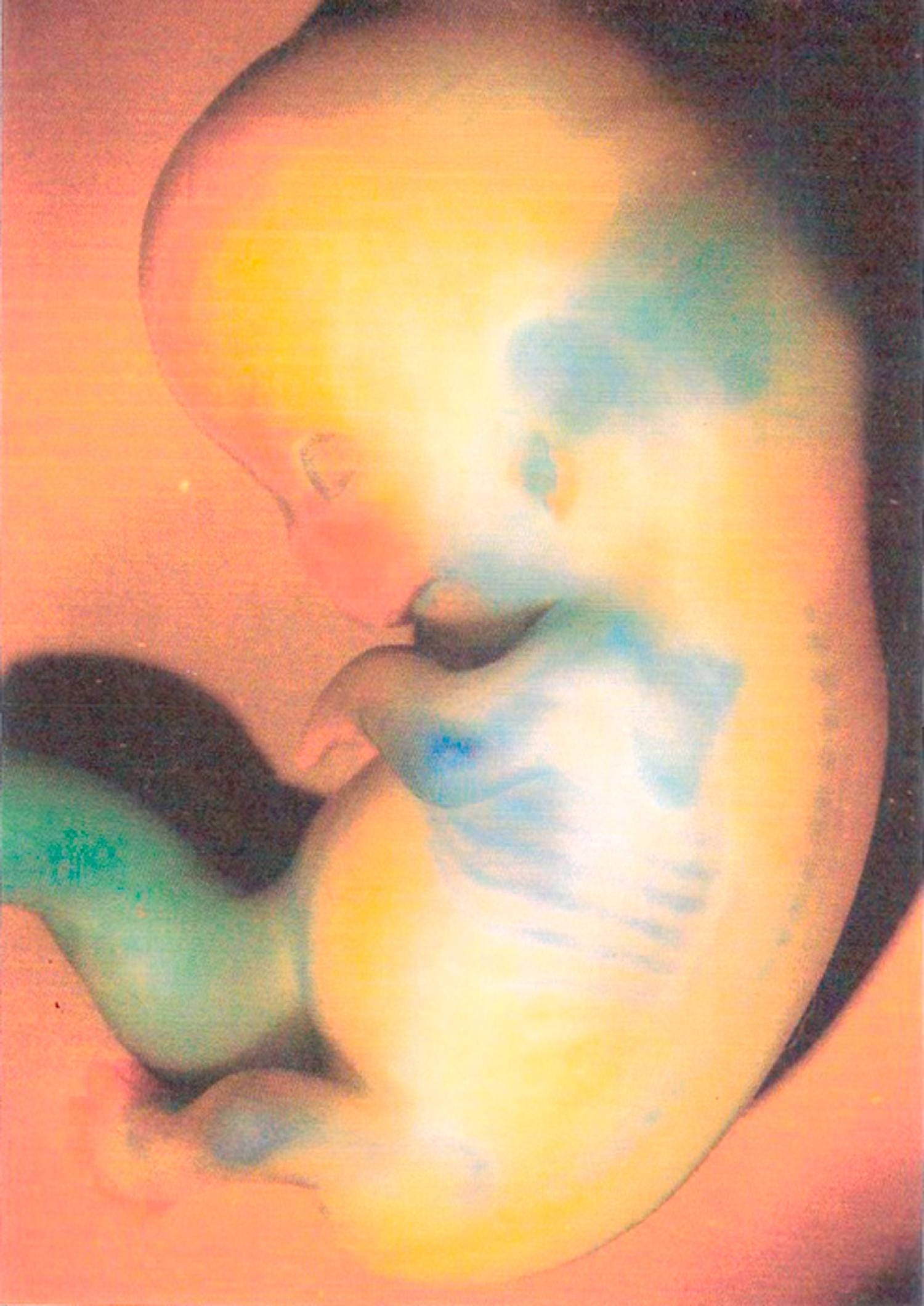
A common element of many mesenchymal cell precursors of skeletal elements is their migration or relative displacement from their site of origin to the area where the bone ultimately forms. The displacement can be relatively minor, such as the aggregation of cells from the sclerotome of the receding somite around the notochord to form the body ( centrum ) of a vertebra, or it can involve extensive migrations of cranial neural crest cells to their final destinations as membrane bones of the face.
To differentiate into defined skeletal elements, the mesenchymal precursor cells must often interact with elements of their immediate environment—typically epithelia with associated basal laminae—or components of the neighboring extracellular matrix. Details of the interactions vary among regions of the body. In the limb, a continuous interaction between the apical ectodermal ridge (see Chapter 10 ) and the underlying limb bud mesoderm is involved in the specification of the limb skeleton. An inductive interaction between the sclerotome and notochord or neural tube initiates skeletogenesis of the vertebral column. In the head, preskeletal cells of the neural crest may receive information at levels ranging from the neural tube itself, to sites along their path of migration, to the region of their final destination. Inductive interactions between regions of the brain and the overlying mesenchyme stimulate formation of the membrane bones of the cranial vault. One of the most important molecular mediators of early bone induction is MSX1,2.
Regardless of the nature of the initial induction, the formation of skeletal elements begins along a common path, which diverges into osteogenic or chondrogenic programs, depending on the nature of the immediate environment. Shortly after induction, the preskeletal mesenchymal cells produce the cellular adhesion molecule N-cadherin , which promotes their transformation from a mesenchymal to an epithelium-like morphology and their forming cellular condensations ( Figure 9.20 ). The growth factor transforming growth factor-β stimulates the synthesis of fibronectin and finally N-CAM , which maintains the aggregated state of the cells in the preskeletal condensation.
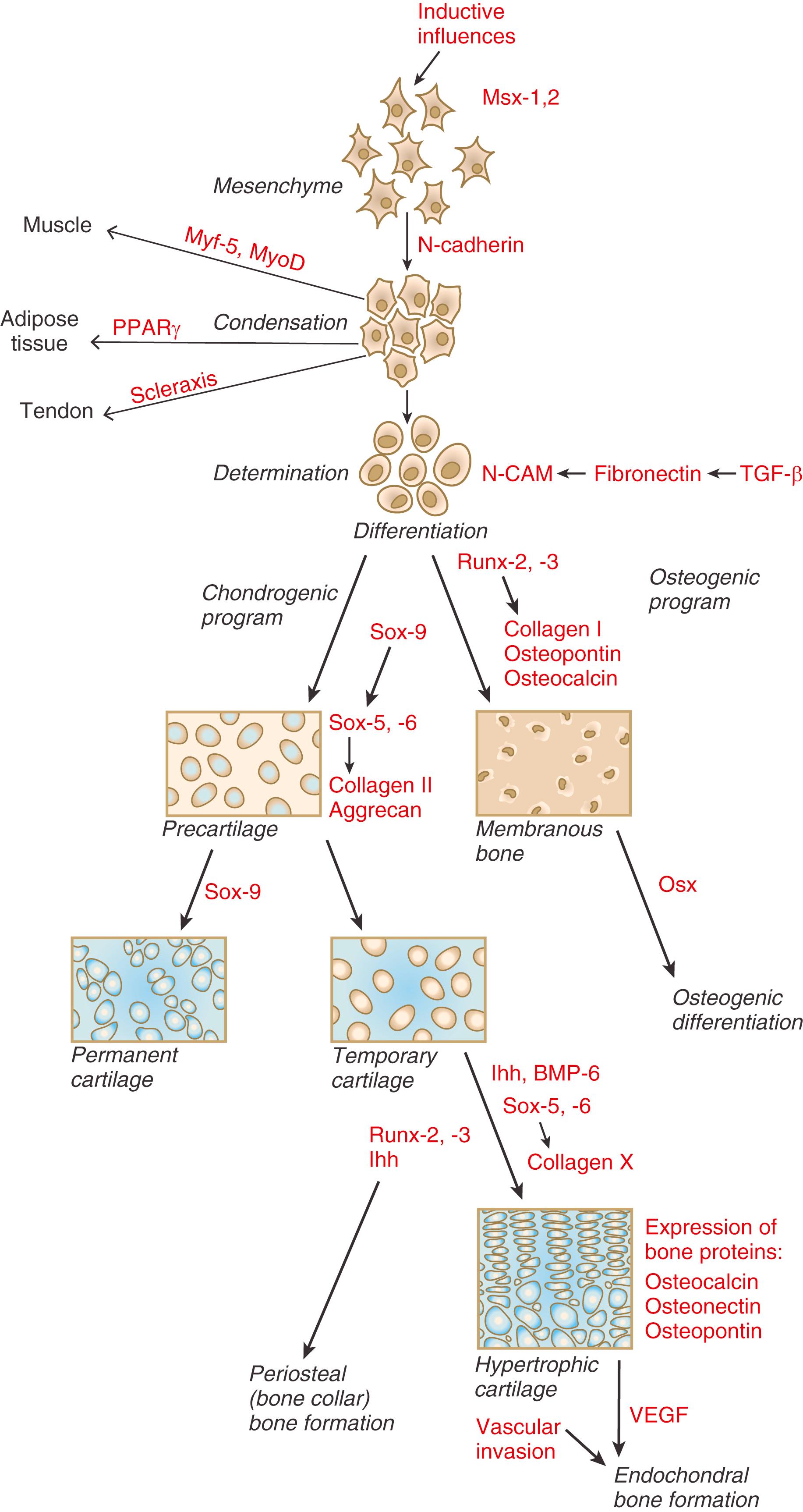
At this point, specific differentiation programs come into effect. If the skeletal element is destined to form membranous bone, the transcription factor Runx-2 sets off an osteogenic program (see Figure 9.20 ). Osterix (Osx) is a downstream transcription factor from Runx-2 and is also required for the differentiation of osteoblasts. The protein encoded by the Runx2 gene has been shown to control the differentiation of mesenchymal cells into osteoblasts (bone-forming cells). These cells produce molecules characteristic of bone (type I collagen, osteocalcin, and osteopontin) and form spicules of intramembranous bone.
Mesenchymal cells can be steered into a cartilage-forming pathway by environmental conditions, such as dense packing or low oxygen. If the cellular condensation is destined to form cartilage, it follows the chondrogenic program . Under the influence of Sox-9 , the chondroblasts begin to form type II collagen and secrete a cartilaginous matrix (see Figure 9.20 ). Some embryonic cartilage (e.g., in the nose, ear, and intervertebral surfaces) remains as permanent cartilage and continues to express Sox-9. The cartilage that forms the basis for endochondral bone formation undergoes specific changes that ultimately promote bone formation around it. A first step is hypertrophy, which occurs under the influence of Runx-2 and the signaling factors Indian hedgehog and BMP-6 . The formation of type X collagen is characteristic of hypertrophying cartilage. Then the hypertrophic chondrocytes themselves begin to produce bone proteins, such as osteocalcin, osteonectin, and osteopontin . They also express vascular endothelial growth factor , which stimulates the ingrowth of blood vessels into the hypertrophic cartilage. This sets the stage for the replacement of the eroded hypertrophic cartilage by true bone as osteoblasts accompany the invading capillaries. FGF-18 , produced by the perichondrium, inhibits the maturation of the chondrocytes around the periphery of the mass of cartilage as those at the center are undergoing hypertrophy.
The mesenchymal cells that are the progenitors of cartilage and bone are also competent to form other tissues, as well (see Figure 9.20 ). Under the influence of the transcription factor scleraxis , these cells can enter a lineage leading to tendon formation. Adipocytes also arise from mesenchymal cell precursors that express another transcription factor PPARγ (peroxisome proliferator-activated receptor γ) .
The human body contains two main types of adipose tissue—white and brown. Whereas white fat is involved mainly in lipid storage and the secretion of cytokines, brown fat cells (adipocytes) are rich in mitochondria and produce metabolically-generated heat.
The two types of adipocytes do not share a common developmental origin ( Figure 9.21 ). Brown adipocytes arise from the dermomyotome and share with early myocytes the expression of the myogenic regulatory factor Myf5 (see p. 183). White adipocytes can be subdivided into several subtypes, each of which has a different lineage. In the trunk and limbs, white adipocytes are, in the main, derived from lateral plate mesoderm, with visceral adipocytes derived from splanchnic mesoderm and subcutaneous trunk and limb adipocytes arising from somatic mesoderm. Dorsal trunk adipocytes are derived from the central dermomyotome, whereas certain adipocytes in the head are neural crest derived.
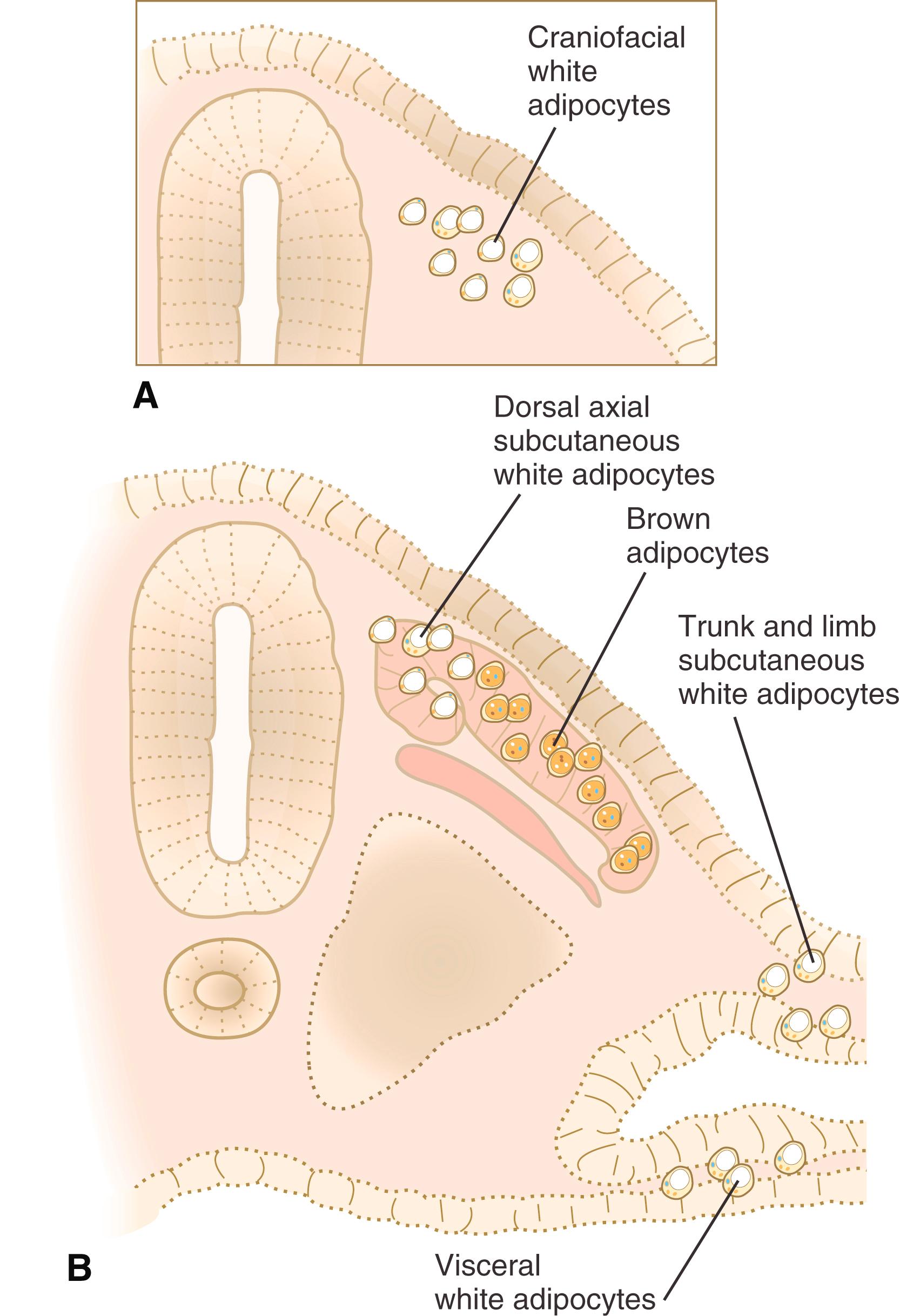
In humans, adipose tissue forms first in the head and neck during the second trimester of pregnancy. This is followed by adipogenesis in the trunk and limbs (see Figure 9.46 ). White fat is widely spread in subcutaneous deposits and in the mesenteries. Brown fat is most prominent in the late fetus and in newborns, where it is found predominantly in deposits between the scapulae, on the shoulders, and along the back. In recent years, its presence in certain adult locations has been confirmed.
Become a Clinical Tree membership for Full access and enjoy Unlimited articles
If you are a member. Log in here